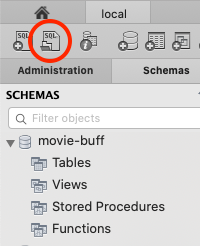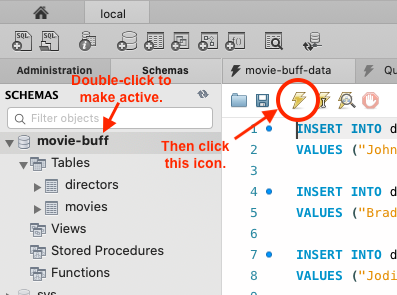1.5. Studio: Movie SQLs¶
In this studio, you will use space in MySQL Workbench to practice writing SQL queries to retrieve or modify information stored in an established database. You will also explore the parallels between objects and database tables.
1.5.1. Walkthrough¶
Let’s relate what you’ve learned about SQL to interact with a database called
movie-buff that contains two tables—movies and directors.
Just as you did in the exercises create the new
movie-buff schema.
Before we create the movies and directors tables, let’s think about
what kind of columns we want in each one.
1.5.1.1. Movies Table¶
For the movies table, it makes sense to have columns for the title of
the movie, the year_released, and the director. We’re also going to
want to have a unique movie_id column as the primary key, since there can
be more than one movie with the same title.
Take the time now to think about what data types you might use for these
columns (INTEGER, VARCHAR, DATE, etc.), then go ahead and write (or
type) the SQL statement to create this table.
As you consider which data types to use for your movies columns, you might
find yourself thinking, If this were a property of an object, what data
type would I use?
For example, if the Movie object has a Title and a Director property,
you would expect both of these data types to be String. Similarly, the year
the movie was released would be stored as an integer. This conceptual overlap
between databases and objects is very useful, and we will explore this
further in the class on Object-Relational Mapping (ORM).
Here’s how our movies table could be created:
1 2 3 4 5 6 | CREATE TABLE movies (
movie_id INTEGER PRIMARY KEY AUTO_INCREMENT,
title VARCHAR(120),
year_released INTEGER,
director VARCHAR(80)
);
|
Take a moment to discuss with a partner:
- Why the two
VARCHARparameters differ in lines 3 and 5. - The purpose behind
PRIMARY KEY AUTO_INCREMENTin line 2. If necessary, review the table setup for the chapter exercises.
1.5.1.2. Directors Table¶
Next, let’s consider the properties we’d want for a Director object.
These could include a FirstName, a LastName, and maybe the
Country where the director was born.
Once we identify the data types for these properties, we can write the SQL
command to create the directors table. Also, we should include a
director_id column in order to create a valid primary key.
1 2 3 4 5 6 | CREATE TABLE directors (
director_id INTEGER PRIMARY KEY AUTO_INCREMENT,
first_name VARCHAR(40),
last_name VARCHAR(40),
country VARCHAR(80)
);
|
1.5.1.3. Relating the Tables¶
Before we go further, let’s take a moment to think about how these two tables
relate to each other, and whether we may want to modify the column director
in the movies table. A director can work on multiple movies, but each
movie may only have one director. Rather than store multiple copies of the same
name in the director column, we can instead reference a single value
stored elsewhere.
Our goal is to keep our table design clean. This means putting data specific
to directors in the directors table, and placing data specific to each
movie in the movies table. To follow this structure, we should NOT store
the director’s name in the movies table.
Similarly, the director’s country is NOT an attribute of a movie, so there is
no need to clutter a movie object or the movies table with that
information. Instead, a name and country are attributes of the director, which
means the data must be stored in the directors table.
However, we might want to know that information for a given movie (e.g. we may
want to find all the movies since 2010 that have French directors). So we need
a way to filter the movies based on attributes from directors. Solving this
challenge is why relational databases exist.
In order to link the two tables to each other, let’s modify the director
column in movies to become director_id. It should therefore be an
INTEGER instead of the VARCHAR we used earlier when we thought the
director column would hold the name of a person.
Note that with the new format, both tables contain a director_id column,
and we will use this match to relate movies with directors. The tool to
establish the link is called a foreign key.
Go ahead and use SQL to delete the old
moviestable:DROP TABLE movies;
Now you need to create a new
moviestable that relates to data stored in thedirectorstable. The code sample below shows how to define thedirector_idcolumn inmoviesas aForeign Key. Doing this links that column inmoviesto thedirector_idcolumn in thedirectorstable.Use this SQL command to create a new
moviestable.1 2 3 4 5 6 7
CREATE TABLE movies ( movie_id INTEGER PRIMARY KEY AUTO_INCREMENT, title VARCHAR(120), year_released INTEGER, director_id INTEGER, FOREIGN KEY (director_id) REFERENCES directors(director_id) );
Line 6 matches every entry in the movies table to the ONE entry in the
directors table that has the same value for director_id. Thus, multiple
rows in movies can reference the same row in directors, and a single
director can connect to many movies.
Note
If needed, here is a set of helpful articles:
Follow the MySQL syntax instructions when there is a syntax variation between the major databases.
1.5.1.4. INSERT Data From File¶
Rather than adding entries line by line, you will use a prepared SQL file to speed up the process.
Follow this link to the movie-buff data repository.
Click the Download Zip button to save a copy of the file to your machine.
Double-click the zip file icon to extract the
movie-buff-data.sqlfile (it will be inside a folder).In MySQL Workbench, click the Open SQL button, and select the
movie-buff-data.sqlfile.
Double-click the
movie-buffschema, then click the leftmost lightning bolt icon to run the SQL script. This will populate thedirectorsandmoviestables.Confirm that the tables contain data by clicking on the table icon next to each name.

OK! Your model is ready to accept queries.
1.5.2. Your Assignment¶
For this studio, you’ll practice writing SQL queries to perform various data
retrieval and manipulation tasks. You will be using the movies and
directors tables described above, so if you still
need to CREATE them, please do so now.
1.5.2.1. Task List¶
Open up a new Query tab in MySQL Workbench. In that tab, write the SQL commands to carry out each of the queries described below. As you complete each step, compare your SQL code and the output with a partner.
List just the titles of all the movies in the database.
List the title and year of each movie in the database in DESCENDING order of the year released. (Hint: Combine the
SELECTcommand with the ORDER BY keywords).List all columns for all records of the
directorstable in ASCENDING alphabetical order based on the director’s country of origin.ORDER BYcan also consider multiple columns. List all columns for all records of thedirectorstable in ASCENDING alphabetical order first by the director’s country of origin and then by the director’s last name.Insert a new record into the
directorstable for Rob Reiner, an American film director.Note
Recall that the column for
director_idis auto incremented, so you don’t need to put in a value for that column.Combine the
SELECTandWHEREkeywords to list thelast_nameanddirector_idfor Rob Reiner.Insert a new record into the
moviestable for The Princess Bride, which was released in 1987 and directed by Rob Reiner.Note
movie_idis also auto incremented, so you don’t need to put in a value for that column. However, you will need to provide a value for the foreign key,director_id, to link the movie to the proper director.If you list all of the data from the
moviestable (SELECT * FROM movies;), you will see a column of director ID numbers. This data is not particularly helpful to a user, since they probably want to see the director names instead. Use anINNER JOINin your SQL command to display a list of movie titles, years released, and director last names.List all the movies in the database along with the first and last name of the director. Order the list alphabetically by the director’s last name.
List the first and last name for the director of The Incredibles. You can do this with either a join or a
WHEREcommand, but for this step please useWHERE.List the last name and country of origin for the director of Roma. You can do this with either a join or a
WHEREcommand, but for this step please use a join.Delete a row from the
moviestable. What consequence does this have ondirectors? List the contents of both tables to find out.Try to delete one person from the
directorstable. What error results from trying to remove a director?
1.5.3. Bonus Missions¶
- Note that SQL aliases give a table or column a temporary name. Assign aliases in at least 3 of the items above to make the columns names different and/or more readable in the output.
- List all of the movies in the database directed by Peter Jackson.
- a. Add another column to
the
moviestable that holds the amount of money earned by each film.- Use
UPDATEto enter these values for each movie in the database. - Generate a list that ranks the movie titles based on earnings.
- Generate a list that only shows films that earned above (or below) a certain amount.
- Use

